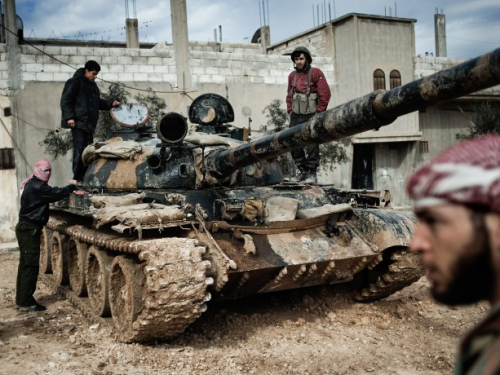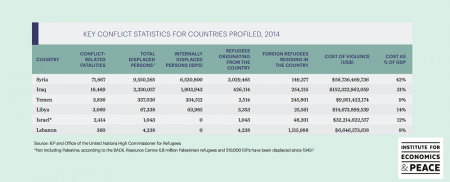
Since the start of the Iraq war, the Middle East has been descending into deeper levels of violence. Currently, most of the countries in the region are either suffering from internal conflicts or being affected by other conflicts. And much of the violence in the region is centred in the two least peaceful countries in this year’s Global Peace Index: Syria and Iraq.
The Global Peace Index, produced by the Institute for Economics and Peace, measures peace in 162 countries according to 23 indicators of the absence of violence or the fear of violence. This year’s GPI discusses the ongoing conflicts in the six Middle Eastern and North African countries most affected by conflict. Syria, Iraq, Yemen, Libya, Israel and Lebanon had the highest number of conflict-related civilian and battle fatalities in the region in 2014, and in many cases, that number has been sharply on the rise.
These conflicts have global significance for a variety of reasons, not least because of their fluid nature and increasing intensity. While there is a lot of uncertainty about how events may unfold, what is clear is that the dynamics underlying these conflicts are complex. The fact that each conflict includes numerous state and non-state participants with different tactical and strategic interests only makes the path to peace less clear. The report highlights some of the more important drivers of violence and sets out some of the opportunities for building peace. It includes a detailed discussion of conflict in each country and addresses the following key themes:
- Five of the six conflicts are internationalised internal conflicts, meaning that international actors are involved in the civil wars.
- Syria, Iraq, Yemen and Libya all face critical challenges to government legitimacy, which serve to exacerbate violent conflict. This failure of state legitimacy has resulted in a power vacuum.
- The Islamic State of Iraq and the Levant (ISIL) is present in Syria, Iraq, Yemen, Libya and recently Lebanon, and its rapid expansion is increasing instability in the broader Levant region.
- Sectarian divides between Sunni and Shia groups both drive violence and are driven by violence.
- Proxy conflicts between Saudi Arabia and Iran are impacting internal civil conflicts.

The ousting of Saddam Hussein’s Ba’athist regime in Iraq began the most recent realignment of power in the Middle East. President Nouri al-Maliki, who replaced Iraq’s post-Hussein transitional government, failed to build consensus between the Sunni and Shia groups in the country. Disenfranchisement of Sunni communities under al-Maliki created the environment for militias to grow, many of which were Islamist and hostile to both Shia-dominated government and Western influences. ISIL was the most successful of these groups and used the context of the Syrian civil war to expand into Syria. Eight of the top ten military leaders of ISIL are believed to be Iraqi Ba’athists and three former Hussein-government generals have joined the organisation.
Religious identity or other loyalties often supersede national boundaries in these countries. Therefore, if the state lacks legitimacy among the population, as the Iraqi government does for many Sunnis in Iraq, citizens are likely to look elsewhere for the benefits typically provided by governments – especially protection. These shortcomings in state legitimacy are evidenced by persistently poor measures of positive peace: the attitudes, institutions and structures that support peaceful societies. For the past decade, the MENA region, and particularly Syria, Iraq, Yemen, Lebanon and Libya, have scored well below average in IEP’s Positive Peace Index.
Indeed, it is an oversimplification to say that divides between Sunnis and Shia, or even Islamists and others, are the only source of conflict (pdf). Many Middle Eastern countries have both Shia and Sunni populations and are relatively peaceful, such as Qatar, Kuwait and the United Arab Emirates. However, as intergroup grievance is a key correlate of violence, the presence of violence heightens sectarian divides. And as a result of low positive peace, the region is lacking in many of the capacities needed to prevent further violence.
These conflicts have complicated relations between Iran and Saudi Arabia, as both governments support competing armed groups which exacerbate other regional dynamics. This is most notable in Yemen where in early 2015 Iran was supporting the Houthis while Saudi Arabia was directly bombing their positions in support of President Abd Rabbuh Mansour Hadi. The regional conflicts are further complicated by the engagement of global powers, such as the US and Russia, who see the region as strategically significant.
Analysis of each conflict highlights what the International Crisis Group calls “the recruitment potential that war and chaos provide.” Mounting tensions and disintegrating security have been advantageous to ISIL. The group has taken advantage of sectarian rhetoric and anti-Western sentiment to swell its ranks with foreign fighters. The power vacuum created by failed or failing states have also increased the appeal of their caliphate as an alternative to problematic governments, albeit at a significant cost.
ISIL has brought a new dimension to the conflicts within the region. On 29 June 2014, ISIL leader Abu Bakr al-Baghdadi declared himself caliph, or ultimate Muslim political and religious leader. In renewing the Levant caliphate, ISIL has attempted to apply an interpretation of Sharia that includes the use of slavery, execution on religious grounds and war as a means of religious salvation. ISIL’s Sunni followers believe themselves to be acting out Quranic prophecy, including victory in an international war.
Although abhorrent to most people, ISIL’s appeal should not be underestimated: the organization is engaged in sophisticated and well-targeted global social media campaigns; it provides a unifying purpose for the disenfranchised; and it is aligned with Wahhabism and the Salafist schools that have broad appeal in Saudi Arabia and other parts of the MENA region. Understanding this appeal in the regional context is critical for countering ISIL’s success.
Containing ISIL requires quelling its source of power: not just territory or its financial sources, but addressing the complex drivers of violence and using a holistic framework to build peace. The Global Peace Index Report discusses the promise of peace in Libya as an example for the region. Where there are fewer and fewer peaceful alternatives, ISIL gains ground.
The Institute for Economics and Peace is the world’s leading think tank dedicated to developing metrics to analyse peace and to quantify its economic value. It does this by developing global and national indices, calculating the economic cost of violence, analysing country level risk and understanding positive peace.

This work is licensed under a Creative Commons Attribution-NonCommercial-NoDerivatives 4.0 International License.
For more information on issues and events that shape our world, please visit ISN Security Watch or browse our resources.

